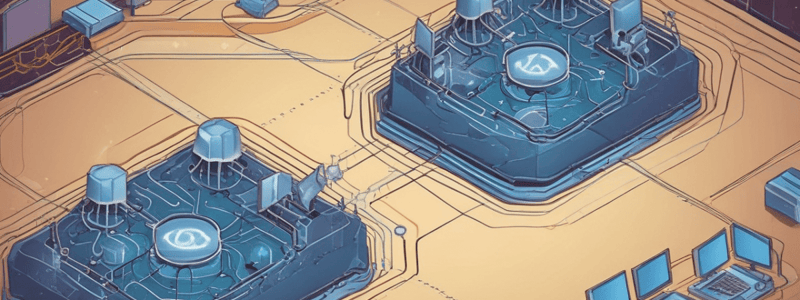Podcast
Questions and Answers
What is the primary function of the Neighbor Table in OSPF?
What is the primary function of the Neighbor Table in OSPF?
- To send OSPF packets to neighboring routers
- To store OSPF routing information
- To calculate the best routes in the network
- To maintain a list of directly connected OSPF routers (correct)
What is the purpose of the Topology Table in OSPF?
What is the purpose of the Topology Table in OSPF?
- To maintain a list of OSPF routers
- To store everything OSPF knows about the network topology (correct)
- To calculate the best routes in the network
- To store OSPF packet information
What is the function of the Routing Table in OSPF?
What is the function of the Routing Table in OSPF?
- To calculate the best routes from the topology table and send them to the routing table (correct)
- To store everything OSPF knows about the network topology
- To store OSPF packet information
- To maintain a list of OSPF routers
What type of packet is used to discover OSPF neighbors?
What type of packet is used to discover OSPF neighbors?
What is the purpose of Database Descriptor (DBD) Packets in OSPF?
What is the purpose of Database Descriptor (DBD) Packets in OSPF?
What type of packet is used to request specific LSAs from another router?
What type of packet is used to request specific LSAs from another router?
Which packet is used to send the requested LSAs to the requesting router?
Which packet is used to send the requested LSAs to the requesting router?
What is the function of Link State Acknowledgement (LS ACK) Packets in OSPF?
What is the function of Link State Acknowledgement (LS ACK) Packets in OSPF?
How many types of packets are involved in every OSPF conversation?
How many types of packets are involved in every OSPF conversation?
Flashcards are hidden until you start studying
Study Notes
OSPF Tables
- OSPF uses three tables to accomplish its goals:
- Neighbor Table
- Topology Table (also referred to as the Link State Database or LSDB)
- Routing Table
- The Neighbor Table:
- Maintained by every OSPF router
- Lists all directly connected OSPF routers
- Holds information such as the state of adjacency with each neighbor
The Topology Table (LSDB)
- Stores everything OSPF knows about the network topology
- A single table that includes all link state advertisements (LSAs)
- Each router has an identical LSDB, ensuring all routers have the same view of the network
- This table is used to calculate the shortest path first (SPF) algorithm
- It contains information about the network, including routers, links, and their respective states
- The LSDB is a crucial component of OSPF, as it enables routers to make informed decisions about routing traffic
- The table is updated dynamically as the network changes, ensuring OSPF routers always have an accurate view of the network topology
- Stores everything OSPF knows about the network topology
- A single table that includes all link state advertisements (LSAs)
- Each router has an identical LSDB, ensuring all routers have the same view of the network
- The Routing Table:
- The router's actual routing table
- Calculates best routes from the topology table and sends them to the routing table
- Decides which routes are best and makes them available in the routing table
OSPF Packets
- 5 packets are involved in every OSPF conversation:
- Hello Packets
- Database Descriptor (DBD) Packets
- Link State Request Packets
- Link State Update (LSU) Packets
- Link State Acknowledgement (LS ACK) Packets
- Hello Packets:
- Sent periodically to the multicast address 224.0.0.5
- Allow routers to discover each other and determine whether to form an adjacency
- DBD Packets:
- Send a summary of LSAs in the LSDB
- Spare routers from sending and receiving the full LSDB
- Routers can request specific LSAs they need
- Link State Request Packets:
- Used to request specific LSAs from another router
- LSU Packets:
- Send the requested LSAs to the requesting router
- LS ACK Packets:
- Confirm receipt of LSU packets
OSPF Tables
- OSPF uses three tables to operate: Neighbor Table, Topology Table (Link State Database or LSDB), and Routing Table
- The Neighbor Table is maintained by every OSPF router, listing all directly connected OSPF routers and their adjacency states
- The Topology Table (LSDB) stores the entire network topology, with each router having an identical LSDB for a shared network view
- The Routing Table calculates best routes from the Topology Table and makes them available for routing decisions
OSPF Packets
- 5 packet types are used in OSPF conversations: Hello, Database Descriptor (DBD), Link State Request, Link State Update (LSU), and Link State Acknowledgement (LS ACK) packets
- Hello Packets are periodically sent to the 224.0.0.5 multicast address to discover routers and form adjacencies
- Database Descriptor (DBD) Packets summarize LSAs in the LSDB, allowing routers to request specific LSAs and avoiding full LSDB transfers
- Link State Request Packets are used to request specific LSAs from other routers
- Link State Update (LSU) Packets send requested LSAs to the requesting router
- Link State Acknowledgement (LS ACK) Packets confirm receipt of LSU packets
Studying That Suits You
Use AI to generate personalized quizzes and flashcards to suit your learning preferences.




